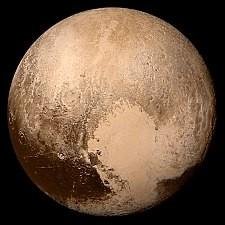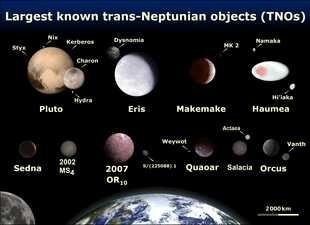THE ECCENTRIC PLUTO

Good day my fellow steemians!! Hope y'all are having a whale of a day, my post today is centered around the dwarf planet PLUTO. Pluto is a dwarf planet in the Kuiper belt, a circle of bodies after the planet Neptune. It was the first Kuiper belt object found by scientists.
Pluto was found by Clyde Tombaugh in 1930 and was now considered to be the ninth planet in our solar system . After 1992, its state as planet was argued by scientists following the discovery of many objects of same size in the kuiper belt. In 2005, Eris, a dwarf planet 27% more massive than Pluto, was discovered. This encouraged the International Astronomical Union (IAU) to define the term planet in 2006, during their 26th General Assembly. That definition removed Pluto and categorized it as a dwarf planet. It became a dwarf planet along with Eris and Ceres. Although a small band of scientists continue to hold that Pluto should still be categorized as a planet
Pluto has five moons: Charon is the biggest with a diameter about half that of Pluto, Styx, Nix, Kerberos, and Hydra.
HOW IT WAS DISCOVERED
 Clyde Tombaugh
Clyde Tombaugh
The director Vesto Melvin Slipher, gave the job to Clyde Tombaugh, a 23-year-old man from Kansas City Tombaugh had just come to the Lowell Observatory. Slipher had been impressed by his astronomical drawings. Tombaugh's had to get pictures of the night sky in pairs for two weeks. Then, he had to look at each pair, to see whether any object had shifted. He used a machine called a blink comparator. He shifted between the different views of each of the plates. It helped him to see if any object had changed it's position. February 18, 1930 was the faithful day Tombaugh discovered an object which seemed to move from the photographic plates taken on January 23 and January 29 of the year. Another picture taken on January 21 confirmed this. After the observatory did more research about it, news of the discovery was sent to the Harvard College Observatory on March 13, 1930.
HOW IS WAS NAMED
This massive discovery was the number one news across the Earth. The Lowell Observatory had the right to name the new object. They received more than 1000 suggestions from all over the world Tombaugh implored director Slipher to suggest a name for the new object quickly before someone else did. The name Pluto was proposed by Venetia Burney. She was an 11-year-old schoolgirl in Oxford, England then. Venetia was a fan of classical mythology and astronomy. The name was of the Roman god of the underworld. She thought it was a good name for a dark and cold world. The name was made official March 24, 1930. Every member of the Lowell Observatory was allowed to vote on a shortlist of three names. The names were Minerva,Cronus, and Pluto. Pluto received all votes. The name was announced on May 1, 1930. In 1941, Glenn T. Seaborg named the newly created element plutonium after Pluto.
CATEGORY
 Artistic comparison of Pluto, Eris,Makemake,Haumea, Sedna,2002 MS4,2007 OR10,Quaoar,Salacia,Orcus, and Earth along with the Moon
Artistic comparison of Pluto, Eris,Makemake,Haumea, Sedna,2002 MS4,2007 OR10,Quaoar,Salacia,Orcus, and Earth along with the Moon
In 1992, many bodies were discovered orbiting in the same volume as Pluto, showing that Pluto is part of a population of objects called the Kuiper belt. This made its official status as a planet controversial, with alot of scientists arguing that Pluto should be considered together with its surrounding population. The Hayden Planetarium reopened in February 2000, after renovations with a model of only eight planets, which made headlines all over the world.
ORBIT OF PLUTO
Pluto's orbital period is presently about 248 years. Its orbital features are different from those of the planets, which follow almost circular orbits around the Sun close to a flat reference plane called the ecliptic. In contrast, Pluto's orbit is delicately inclined relative to the ecliptic (over 17°) and moderately eccentric.
ROTATION PERIOD
Pluto's rotation period, its day, is equal to 6.39 Earth days. Pluto rotates on its side in its orbital plane, with an axial tilt of 120°, and so its seasonal variation is extreme; at its solstices, one fourth of its surface is in continuous daylight, and another fourth is in continuous darkness. The reason for this unusual orientation has been argued amongst scientists. Research from University of Arizona has claimed that it may be due to the way that a body's spin will always adjust to minimise energy. This might mean a body reorienting itself to put extraneous mass near the equator and regions lacking mass tend towards the poles.
GEOLOGICAL FORMATION
Pluto's surface are composed of more than 98 percent nitrogen ice, with traces of methane and carbon monoxide. Nitrogen and carbon monoxide are most abundant on the anti-Charon face of Pluto, Although methane is most abundant near 300° east. Pluto's mountains are made of water ice.
SIZE
Pluto's diameter is 2376.6±3.2 km and its mass is (1.303±0.003)×1022 kg, 17.7% that of the Moon (0.22% that of Earth). It's surface area is 1.779×107 km2, about the same surface area as Russia. Its surface gravity is 0.063 g (compared to 1 g for Earth).
Pluto has an atmosphere consisting of nitrogen (N2), methane (CH4), and carbon monoxide (CO), which are equal with their ices on Pluto's surface
SATELLITES AROUND PLUTO
Pluto has five known satellites although their are possibilities of more being found. Charon, first identified in 1978 by astronomer James Christy, Nix and Hydra, both discovered in 2005, Kerberos was discovered in 2011, and Styx was discovered in 2012.The satellites orbits are circular (eccentricity < 0.006) and coplanar with Pluto's equator (inclination < 1°), and therefore tilted approximately 120° to Pluto's orbit.
If u enjoyed this post please resteeem, vote and follow God bless you
Gradually, Steemit is becoming an encyclopedia
This post has received a 0.16 % upvote from @drotto thanks to: @banjo.
It's a read I'm glad I came across. Nice piece!
Thanks for stopping by, God bless
"Pluto" though not really regarded as a complete planet according to recent day research, is the "coldest" so far of all planets in the solar system..
Spot on!! Nice one @profsam
This is interesting and educative. I once wrote about planets too.. Its an interesting study...try and reference your images though
Thanks for taking ur time to read my post I really appreciate, but as for the reference I put the addresses where each photo was picked, its under the "image reference" or did I do it wrong? I am open to correction